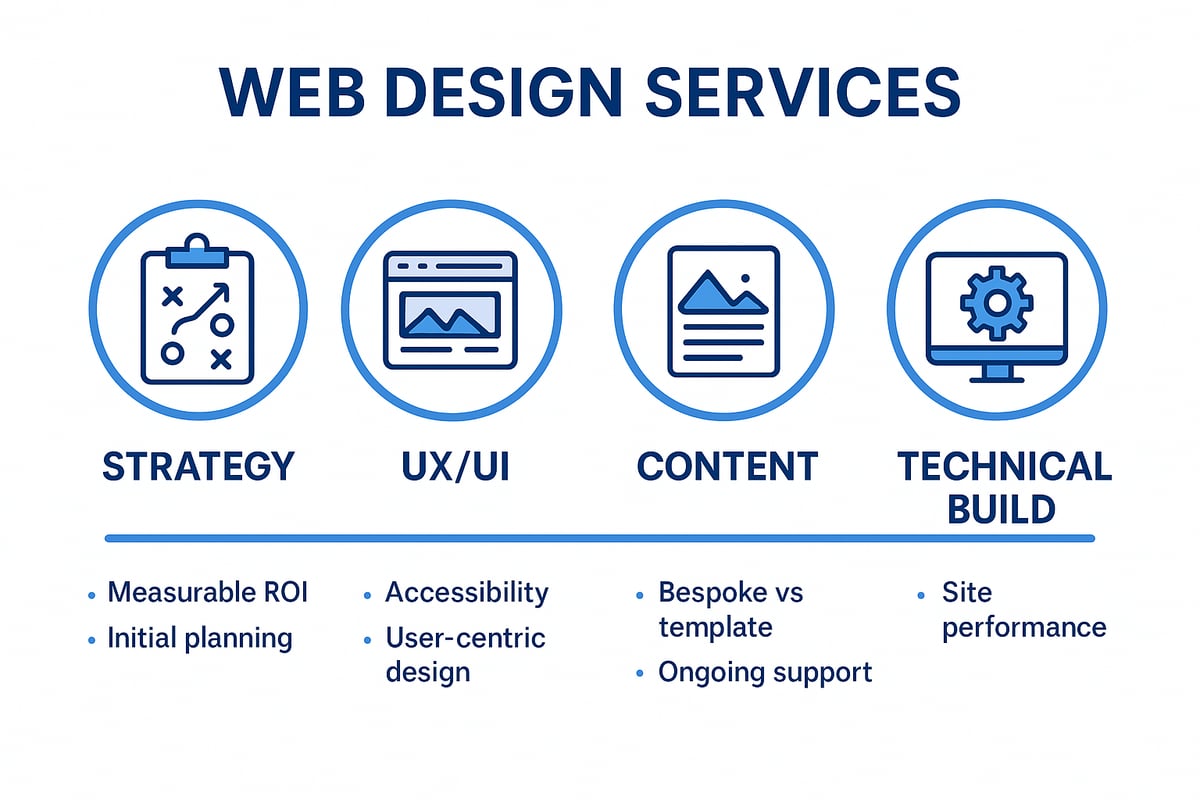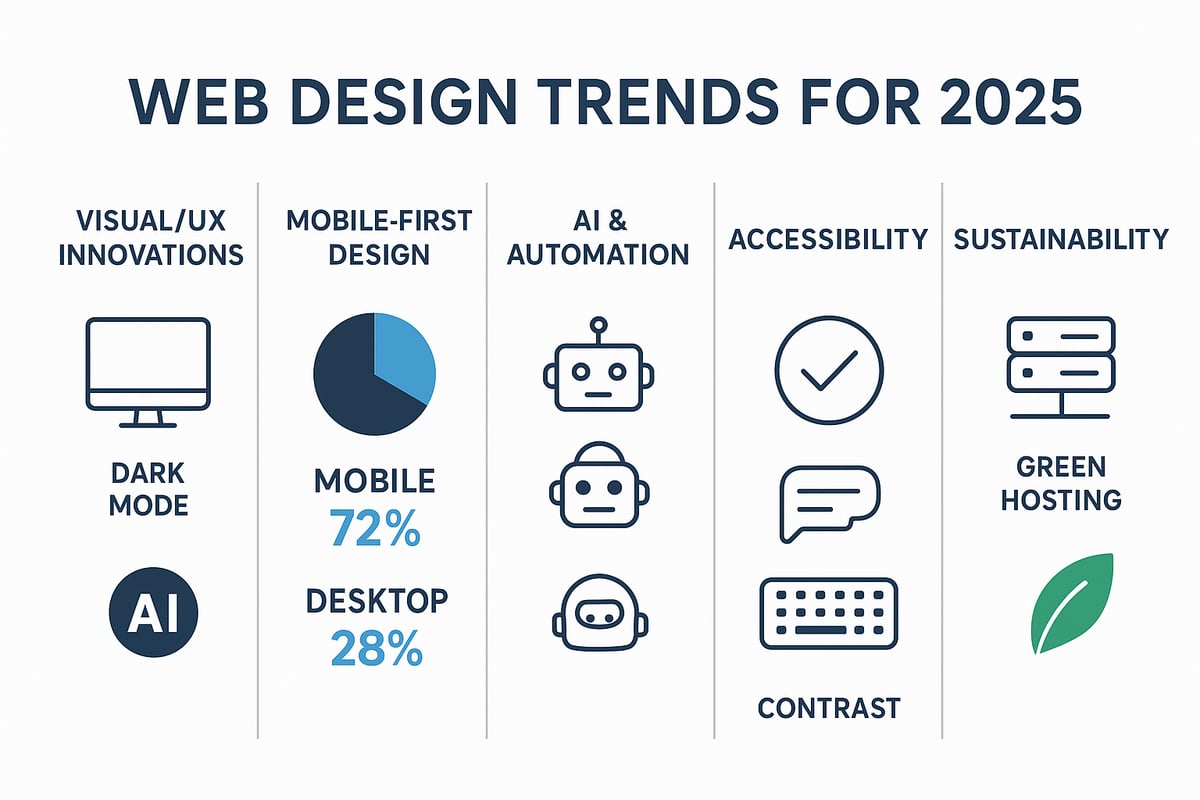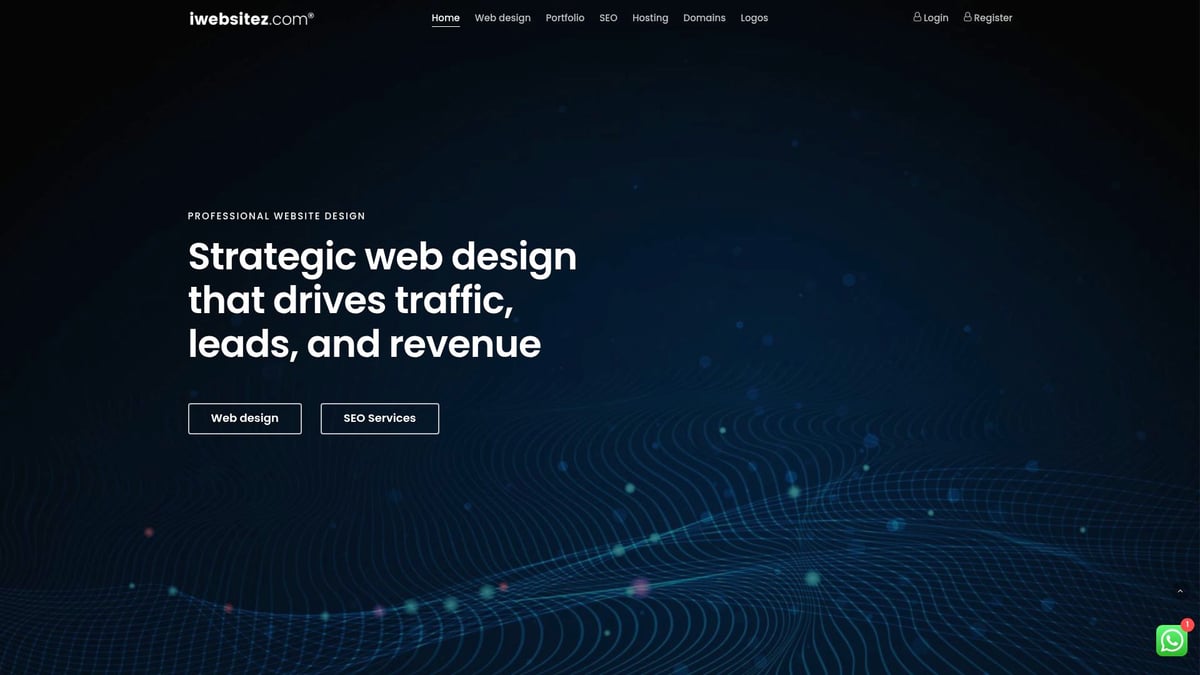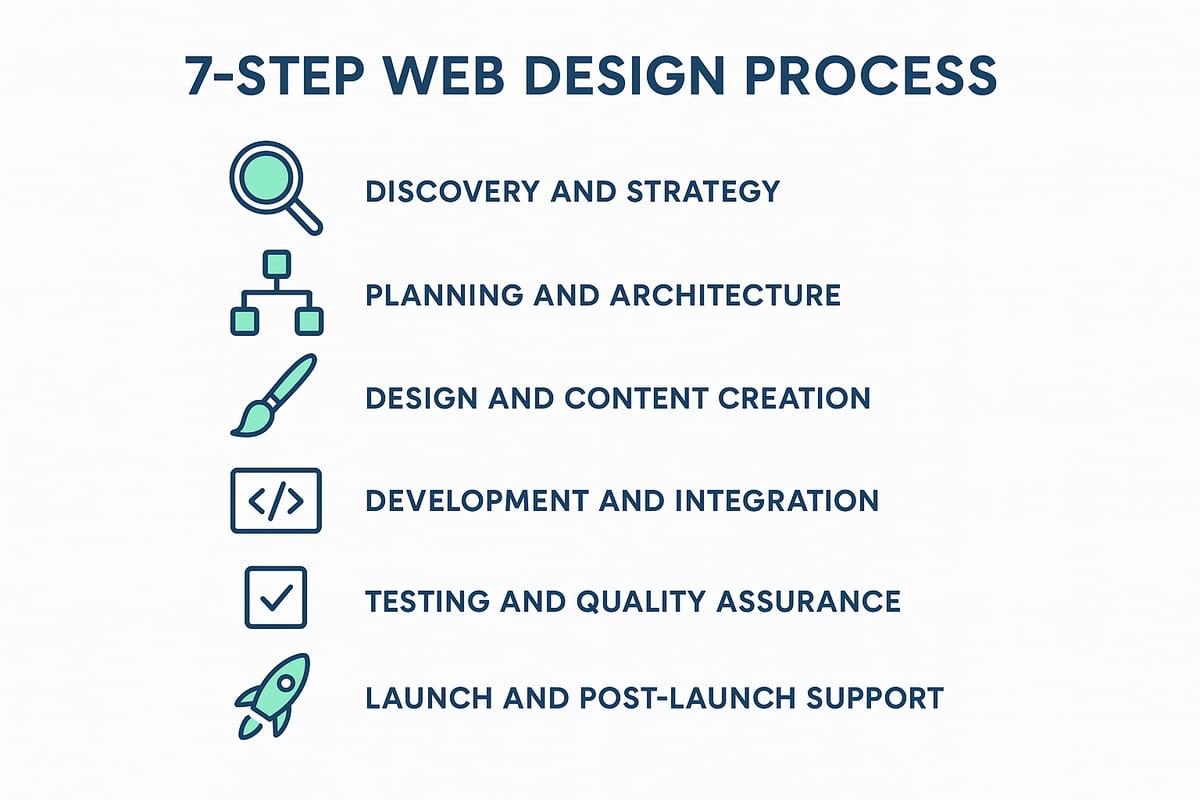In 2025, your website is the digital front door to your business. Are you ready to make a powerful first impression? The world of web design services is evolving quickly, reshaping how brands connect with their audiences online.
Today’s businesses face new technologies, rising user expectations, and tougher competition. Staying ahead means understanding the latest trends and making informed choices about your web design services partner.
This guide is here to help you navigate the changing landscape. You will discover actionable steps to select, implement, and maximise web design services for measurable results.
Follow our step-by-step advice to ensure your online presence not only survives but thrives in 2025.
Understanding Web Design Services in 2025
In 2025, web design services have evolved beyond simply creating attractive websites. Businesses now demand digital experiences that are functional, measurable, and aligned with strategic goals. Understanding what modern web design services encompass is essential for anyone looking to thrive in a competitive online landscape.

Defining Modern Web Design Services
Web design services in 2025 refer to comprehensive solutions that cover every aspect of a business’s online presence. These services go far beyond aesthetics, integrating strategy, branding, and technology to deliver both form and function.
It is important to distinguish web design services from web development. While web design services focus on the look, feel, and user experience, web development deals with building the underlying functionality and coding. Other related digital services, such as branding and digital marketing, often overlap but remain distinct.
Examples of web design services include custom design, UX and UI enhancements, mobile responsiveness, and seamless branding integration. Businesses are increasingly seeking holistic digital solutions that focus on measurable goals, such as increased conversions, more leads, and stronger brand awareness.
Key Components of a Comprehensive Web Design Service
A comprehensive approach to web design services involves several critical components. Strategy and planning come first, ensuring your website aligns with your business objectives.
UX and UI design are central, focusing on accessibility, intuitive navigation, and a seamless user journey. Content creation covers everything from persuasive copywriting to high-quality imagery and engaging multimedia.
Technical build is another essential component of web design services, including CMS integration, reliable hosting, and performance optimisation. Ongoing support is vital for long-term success, covering maintenance, analytics, and continuous improvements to keep your site up to date.
Types of Web Design Services Available
The landscape for web design services in 2025 is diverse. Businesses can choose between bespoke (custom) design, which offers complete flexibility and uniqueness, and template-based solutions that provide cost-effective, faster launches.
Specialised web design services cater to specific needs, such as e-commerce, portfolios, SaaS platforms, B2B, and informational sites. Service providers range from full-service agencies to freelancers and in-house teams.
Many web design services also offer valuable add-ons, including SEO, branding, hosting, conversion rate optimisation, and digital marketing. For instance, agencies like Ketchup Marketing tailor their web design services to suit different business models and industry requirements.
The Value Proposition of Professional Web Design
Investing in professional web design services yields measurable business benefits. Data from the Virti case study (via Ketchup Marketing) shows sign-ups increasing by 300 percent after a website redesign.
Expert web design services drive conversions, improve SEO rankings, and boost user retention by delivering a polished, trustworthy online presence. Businesses can build credibility and trust with visitors through consistent branding and intuitive design.
Analytics and KPIs are integrated into service delivery, enabling ongoing measurement and optimisation. The long-term ROI of quality web design services often far outweighs initial costs. For real-world inspiration, explore best website design examples that showcase the impact of professional design on business success.
Emerging Trends and Technologies Shaping Web Design
Staying competitive in 2025 means keeping pace with the rapid changes influencing web design services. From visual innovation to eco-friendly development, the latest trends are transforming how businesses connect with their audiences and drive results. Let’s explore the key advancements shaping the future of web design services.

Visual and UX/UI Innovations
Web design services in 2025 are defined by a strong focus on minimalist, user-centric, and accessible design. Brands prioritise intuitive interfaces that reduce clutter and guide users seamlessly through content. Dark mode options, micro-interactions, and immersive visuals are now standard, enhancing both engagement and accessibility.
The integration of AI-driven personalisation adapts layouts and content to individual preferences, while advanced prototyping tools like Figma and Adobe streamline design workflows. For a deeper dive into the most current approaches, see the latest web design trends shaping the industry.
These innovations ensure that web design services remain effective at capturing attention and fostering positive user experiences.
Mobile-First and Responsive Design
With over 60 percent of global web traffic now originating from mobile devices, mobile-first thinking is essential for web design services. Google’s mobile-first indexing means that websites must prioritise seamless experiences across smartphones and tablets to maintain visibility and ranking.
Techniques such as flexible grids, adaptive images, and intuitive mobile navigation are now fundamental. Fast loading times are equally critical, as users expect instant access to content. Web design services that excel in mobile responsiveness will keep businesses ahead in a mobile-dominated landscape.
Integration of AI and Automation
AI and automation are revolutionising web design services in 2025. AI-powered design tools accelerate wireframing and layout decisions, while chatbots and virtual assistants provide real-time support and guidance for website visitors.
Personalised recommendations, driven by user data, help brands deliver tailored experiences that boost engagement and conversions. AI domain name generators and reputation management tools further streamline the digital presence. As AI continues to advance, its role in web design services will only grow more significant and impactful.
Accessibility and Inclusivity in 2025
Legal and ethical requirements are driving web design services to adopt robust accessibility standards. Compliance with WCAG 2.2+ ensures websites are usable by all individuals, including those relying on keyboard navigation or screen readers.
Essential features include high-contrast colour schemes, clear focus indicators, and alternative text for images. Case studies show that improved accessibility not only increases dwell time but also drives higher conversion rates. Inclusive web design services are now a necessity, not a luxury, for modern businesses.
Sustainability and Green Web Design
Sustainability is a rising priority for web design services, as eco-conscious consumers demand greener digital solutions. Agencies are adopting energy-efficient hosting, optimised code, and lighter media assets to reduce the carbon footprint of every site.
Green hosting providers and sustainable development practices are becoming part of agency brand promises, appealing to environmentally aware clients. By integrating sustainability into web design services, businesses can demonstrate responsibility while improving site performance.
Choosing the Right Web Design Partner
Selecting the right web design partner is one of the most critical decisions for your business in 2025. The market is filled with providers offering web design services, but not all are created equal. To ensure your investment delivers results, you need a clear set of criteria and a structured approach to evaluation.
Key Criteria for Selecting a Web Design Service Provider
When evaluating web design services, start by reviewing the provider’s portfolio. Look for diversity and results in projects relevant to your industry. Assess their credentials and certifications, as well as client testimonials that reflect successful outcomes.
Transparent communication is essential. Ask about their project management style and how they keep clients informed at each stage. Pricing must be clear, with deliverables and timelines outlined from the beginning. For a step-by-step approach to selection, see this detailed guide on Choosing a web design agency.
Questions to Ask Potential Agencies or Freelancers
To make the most of your web design services investment, prepare a list of key questions:
- What is your process from discovery to launch?
- How do you measure success and report on results?
- Which technologies and platforms do you specialise in?
- Can you provide relevant case studies or references?
- How is ongoing maintenance and support managed?
Asking these questions helps you gauge their expertise, alignment with your goals, and commitment to long-term support.
Comparing Pricing Models and Contracts
Web design services are offered through various pricing models. The most common are fixed price, hourly, and retainer agreements. Each has its pros and cons. Fixed price provides clarity, while hourly allows flexibility. Retainers are ideal for ongoing needs.
| Model | Pros | Cons |
|---|---|---|
| Fixed Price | Predictable costs | Less flexibility |
| Hourly | Pay for actual work | Costs can escalate |
| Retainer | Ongoing partnership | Requires regular budget |
Ensure you know what’s included: design, development, content, SEO, and support. Watch for hidden costs such as revisions, hosting, or licensing fees.
iwebsitez.com: A Trusted Web Design Company
Established in 2013, iwebsitez.com delivers custom web design services, SEO, and hosting. Their team brings over 30 years of combined experience to every project.

They focus on high-performance, visually appealing, and results-driven websites. Processes are transparent, with rigorous quality assurance and a client-centric approach. For businesses seeking comprehensive digital solutions, iwebsitez.com is a reliable choice.
The Web Design Process: Step-by-Step Guide for 2025
Embarking on a successful web project in 2025 means following a structured, strategic process. Modern web design services rely on proven steps to turn your vision into a high-performing digital asset. Let us walk through each key phase, so you know exactly what to expect from start to finish.

Step 1: Discovery and Strategy
Every effective web design services project begins with discovery. This phase involves in-depth consultations to understand your business goals, target audience, and unique selling points.
Market research and competitor analysis help set the context, ensuring your website will stand out. The team works with you to define measurable objectives and key performance indicators.
Mapping customer journeys at this stage ensures every future design choice aligns with desired business outcomes. Clear strategy from the outset reduces risk and supports a focused, collaborative process.
Step 2: Planning and Architecture
During planning, web design services experts create a blueprint for your site. This includes sitemaps, wireframes, and user flow diagrams that organise content and features logically.
The planning stage is essential for structuring information clearly, supporting both user experience and SEO. Deciding on the technology stack and content management system ensures your site is scalable and manageable.
Designers, developers, and stakeholders collaborate closely, making sure every requirement is captured before moving forward. Solid planning helps prevent costly changes later in the process.
Step 3: Design and Content Creation
With architecture in place, the creative work begins. Web design services focus on crafting your visual identity. This includes selecting colour palettes, typography, and imagery that reflect your brand.
UX/UI design principles ensure accessibility and engagement, while designers use tools like Figma and Adobe Creative Suite for prototyping. Content specialists write compelling copy and source multimedia assets to enhance storytelling.
By blending creativity and strategy, this phase produces a captivating and conversion-driven website design, tailored for your audience.
Step 4: Development and Integration
Now, your website takes shape through technical build. Web design services developers write clean, efficient code for both front-end and back-end systems.
The team configures your chosen CMS, such as WordPress or Shopify, and builds any custom features you need. Integration of third-party tools, like analytics, chatbots, or e-commerce platforms, happens here.
Rigorous attention to mobile responsiveness and cross-browser compatibility ensures a seamless experience for every visitor. Collaboration between developers and designers keeps the project on track.
Step 5: Testing and Quality Assurance
Before launch, thorough testing is critical. Web design services teams check all functional aspects, including forms, navigation, and interactive features.
Performance optimisation is a top priority. This means compressing images, enabling caching, and improving load times. Accessibility audits ensure the site meets WCAG standards, and user testing provides valuable feedback.
Security checks, like SSL implementation and GDPR compliance, protect your data and build user trust. Quality assurance guarantees a polished, reliable website.
Step 6: Launch and Post-Launch Support
The launch phase is where all the preparation pays off. Web design services follow a detailed pre-launch checklist: setting up redirects, configuring SEO, and enabling analytics.
The go-live process is carefully monitored to resolve any issues immediately. Post-launch, your provider offers support for bug fixes, content updates, and ongoing optimisation.
Training sessions help your team manage the CMS and use analytics tools effectively. This hands-on support ensures your investment delivers long-term value.
Step 7: Measuring Success and Continuous Improvement
Once live, measuring your website’s performance is essential. Web design services set up tracking for KPIs such as traffic, conversions, and engagement.
Analytics platforms like Google Analytics and Microsoft Clarity provide actionable insights. Regular reviews enable iterative improvements, guided by real user feedback.
Continuous optimisation is vital in today’s digital landscape. According to Web Design Statistics for 2025, data-led updates can significantly boost user satisfaction and business outcomes. Ongoing measurement ensures your web presence evolves with market trends.
Integrating SEO and Digital Marketing into Web Design
A successful website in 2025 requires more than aesthetic appeal. Integrating SEO and digital marketing into your web design services is essential for visibility, engagement, and growth. Every aspect, from site structure to ongoing campaigns, should work together to support your business goals.
SEO Best Practices for Web Design in 2025
Technical SEO is the foundation of high-performing web design services. Modern websites must feature a logical site structure, mobile optimisation, and proper schema markup. On-page SEO, including keyword research, meta tags, and clear content hierarchy, is equally vital.
Fast loading times and Core Web Vitals compliance are now non-negotiable. Building sites with SEO in mind from the start boosts rankings and user experience. For an in-depth look at combining these elements, see this guide on SEO and web design integration.
Content Strategy and Conversion Optimisation
Content is the engine of digital marketing within web design services. Begin by creating valuable, keyword-rich content tailored to your target audience. Incorporate clear calls-to-action and lead capture forms to drive conversions.
Use analytics tools to refine your messaging and optimise user journeys. Well-structured content improves engagement and supports SEO goals. Strong content strategy ensures your web design services remain effective and relevant.
Integrating Digital Marketing Tools and Services
Modern web design services must accommodate a range of digital marketing tools. Email marketing, social media integration, and paid advertising platforms should be seamlessly connected to your site.
Reputation management and review platforms can be integrated for added trust. Marketing automation and CRM systems streamline lead nurturing and customer retention. Choosing web design services that support these tools ensures your site is ready for comprehensive campaigns.
Measuring and Reporting on Digital Performance
Ongoing measurement is critical to maximising your investment in web design services. Set up dashboards for real-time performance monitoring, tracking conversions, bounce rates, and ROI.
Regular reporting enables data-driven decision making. Use A/B testing and user feedback for continuous improvement. This approach ensures your web design services adapt to market changes and business objectives.
Cost, ROI, and Future-Proofing Your Website Investment
Understanding the investment in web design services is crucial for any business aiming to succeed online in 2025. From initial costs to long-term returns, every decision impacts your growth and digital resilience. Let’s break down the essentials to help you make informed choices.
Factors Influencing the Cost of Web Design Services
The cost of web design services varies based on several core factors. The scope of your project, including the number of pages and required features, plays a significant role. Custom solutions typically cost more than template-based sites, as they demand more design and technical input.
Other considerations include the complexity of functionality, such as e-commerce integration or bespoke content management systems. Ongoing support, hosting, and maintenance fees also contribute to the total investment. For example, some agencies offer tailored quotes rather than fixed pricing to reflect your unique business needs.
Here’s a quick summary of what can influence your budget:
| Factor | Impact on Cost |
|---|---|
| Number of Pages | More pages, higher cost |
| Custom Features | Increases complexity |
| Content Creation | Adds copy and media |
| Ongoing Support | Recurring fees |
| Hosting & Security | Essential add-ons |
Careful planning ensures you only pay for what you really need from your web design services.
Calculating Return on Investment (ROI)
Measuring ROI from web design services means tracking metrics that matter, such as leads, sales, and user engagement. Quality design consistently delivers better results over time, as a professional site drives more conversions and builds brand trust.
Look for case studies or statistical evidence of performance improvements. For instance, businesses that invest in modern, user-focused design often see measurable gains in sign-ups and impressions. To understand industry benchmarks and trends that influence ROI, review Web Design Trends and Insights.
Remember, the true value of web design services lies in their long-term benefits, not just the initial savings. Use analytics tools to attribute revenue and growth directly to your digital investment.
Future-Proofing Your Website for 2025 and Beyond
To ensure your web design services investment stands the test of time, focus on scalability and adaptability. Select platforms and technologies that allow for updates without major overhauls. Modular builds make it easy to add new features as your business evolves.
Regular updates to design, content, and security are essential. Stay ahead by incorporating trends like voice search, AI tools, and new device compatibility. Building a strong partnership with your web design services provider ensures proactive support and ongoing optimisation.
Prioritise a flexible approach so your website can adapt to changing user expectations and market conditions.
Common Pitfalls and How to Avoid Them
Many businesses underestimate the complexity or timeline of web design services projects. Skipping mobile optimisation or accessibility can result in lost opportunities and legal challenges. Focusing solely on price often leads to disappointing outcomes and higher costs in the long run.
Avoid these pitfalls:
- Failing to define clear project goals
- Overlooking mobile and accessibility standards
- Neglecting ongoing optimisation and updates
- Choosing providers based only on cost, not expertise
Prepare for a successful website launch by planning thoroughly and selecting partners who understand both your industry and your ambitions.
